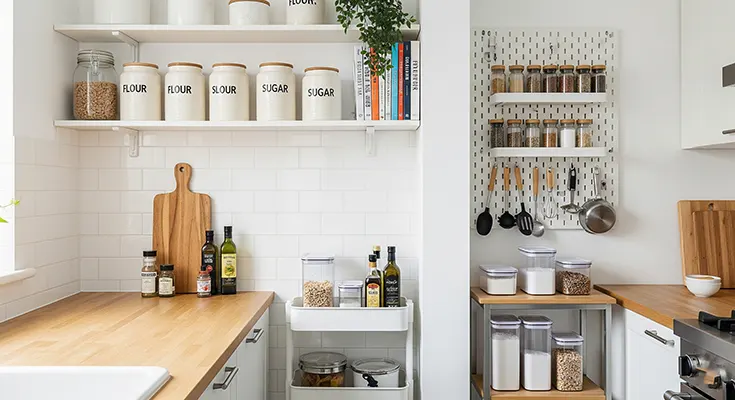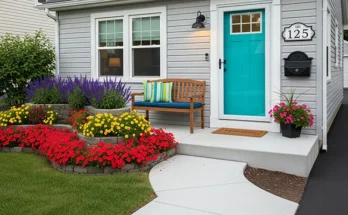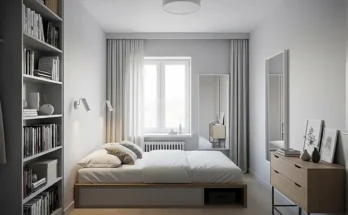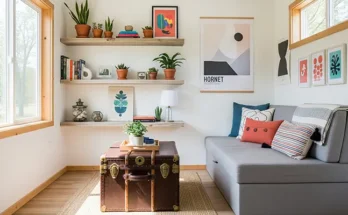A small kitchen can feel like a culinary cage, especially when the crucial element—a pantry—is missing. If you’re constantly playing a game of Tetris with your groceries, canned goods, and appliances, you’re not alone. The good news is that you don’t need a massive walk-in closet to create a functional, organized food storage system. You just need to get creative with the space you have.
Here are the best strategies for faking a pantry that’s both functional and stylish:
1. Master the Vertical Space
When floor space is scarce, the walls and up-high spots become your prime real estate. Think upward, not outward.
- Floating Shelves for Display: Install open shelving for items that look good and are frequently used. Decant dry goods like pasta, flour, sugar, and grains into matching clear containers or beautiful glass jars. This looks intentional, makes finding ingredients easy, and frees up cabinet space.
- Utilize Wall-Mounted Systems: A pegboard (like the famous ones in Julia Child’s kitchen) is incredibly versatile. Use hooks and small shelves to hang pots, pans, utensils, and even small baskets for spices or produce. Alternatively, a simple pot rail with S-hooks can clear a lower cabinet in an instant.
- Over-Cabinet Storage: The space above your upper cabinets is perfect for storing items you don’t use daily, such as seasonal dishes, bulk paper goods, or backup appliances. Use attractive, lidded baskets to keep things tidy and dust-free.
2. Revolutionize Your Cabinets and Drawers
Your existing cabinetry is the foundation of your “faux pantry.” Make every inch work harder with smart inserts and organization tricks.
- Door-Mounted Racks: The inside of your cabinet doors is often overlooked. Install narrow spice racks or small wire baskets here to store spices, foil, plastic wrap, or even pot lids.
- Lazy Susans (Turntables): Place a Lazy Susan in corner cabinets or even on deep shelves. These spinning organizers bring back-of-the-cabinet items to the front with a simple spin. They are perfect for oils, vinegars, and canned goods.
- Tiered Organizers and Risers: Maximize the vertical space inside cabinets by adding step-shelves or risers. This allows you to stack cans, jars, and spices in visible tiers, so you never buy duplicates of the same thing again.
- Designated “Pantry” Cabinet/Drawer: Dedicate one full upper cabinet or a deep drawer to dry food storage. Use clear, stackable, airtight containers to store bulk ingredients—this removes bulky, odd-shaped packaging and maximizes the available space.
3. Bring in Mobile and Freestanding Storage
If you truly have no space in your built-in cabinets, it’s time to purchase a piece of furniture that can serve a dual purpose.
- The Rolling Utility Cart: A small, multi-tiered cart on wheels is the ultimate mobile pantry. It can store canned goods, fresh produce, snacks, or even small appliances. When you need it, roll it out for easy access; when you need floor space, tuck it into a corner or next to the fridge.
- Repurpose Furniture: A narrow bookshelf, an attractive sideboard, or even a slim armoire in a nearby dining area can be transformed into a stylish, full-sized pantry. Add baskets and internal organizers to keep the food items hidden and neat.
- Over-the-Door Organizers: If you have a nearby closet, mudroom, or even a laundry room adjacent to the kitchen, hang a clear, over-the-door shoe or pantry organizer. The pockets are ideal for boxed mixes, packaged snacks, spices, and lightweight dry goods.
The Foundation: Decluttering
Before you buy a single organizer, the most critical step is decluttering ruthlessly. A small kitchen with no pantry forces you to be honest about what you truly need.
- Purge: Toss anything expired. Donate duplicate appliances or tools you rarely use.
- Downsize: If you can’t buy in bulk, don’t. Adjust your shopping habits to only keep what you can store comfortably.
- Contain: Remove bulky packaging and decant to save 20-30% more space.
A small kitchen without a pantry is not a curse—it’s an opportunity for clever design. By thinking vertically, organizing internally, and embracing flexible furniture, you can create a creative storage system that keeps your kitchen functional, streamlined, and ready for your next culinary adventure.





